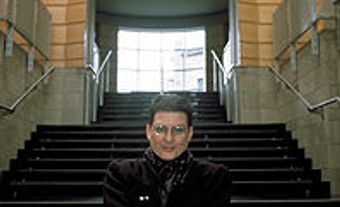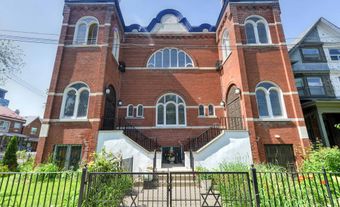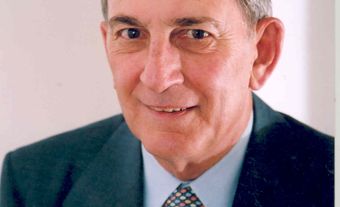Descendants of Russian immigrant tobacco farmer Yechiel (Ekiel) Bronfman and his wife, Mindel, members of the Bronfman family have owned and controlled huge financial empires built from the profits of the family liquor business (see Seagram). The best-known members of the family are Samuel Bronfman, founder of Seagram and president of the Canadian Jewish Congress (1939–62), and his descendants. Samuel’s wife, Saidye Rosner Bronfman, was an influential philanthropist who supported the arts in Canada and was awarded the Order of the British Empire for organizing work on the home front during the Second World War. Sons Edgar and Charles Bronfman ran Seagram for decades, while grandson Edgar Miles Bronfman Jr. oversaw the sale of Seagram to Vivendi. Charles was also co-founder of the Historica Foundation of Canada and Heritage Minutes, as well as chairman and principal owner of the Montreal Expos. His sister Phyllis Lambert is a well-known architect who founded the Canadian Centre for Architecture. Their cousins, Edward and Peter Bronfman (sons of Allan Bronfman), developed a financial empire in their own right. The family has given generously to several charitable organizations and been involved in the Canadian Jewish Congress and World Jewish Congress.
Bronfman Origins in Canada
Mindel and Yechiel Bronfman immigrated to Canada with their children in 1889, fleeing the anti-Semitic pogroms of czarist Russia. The Bronfman family settled at a homestead near Wapella, Saskatchewan, but soon moved to Brandon, Manitoba, where Yechiel started a wood-fuel delivery business with his three eldest sons, Abe (born 15 March 1882 in Russia; died 16 March 1968 in Safety Harbor, Florida), Harry (born 15 March 1886 in Russia; died 12 November 1963 in Montreal, QC) and Samuel (born 27 February 1889 in Soroki, Bessarabia, or en route from Russia; died 10 July 1971 in Montreal). Samuel and his seven siblings experienced a childhood of poverty and hard work. In 1903, the family borrowed money to buy the Anglo-American Hotel in Emerson, Manitoba. Yechiel emerged as a leader in the local Jewish community and sent money to assist Jewish communities in eastern Europe.
The hotel business boomed with railway construction. In 1906, the family moved to Winnipeg and, by the middle of the First World War, they were running three profitable hotels there. With the coming of Prohibition in Canada, the Bronfmans turned their energy to the interprovincial packaged liquor trade and purchased stocks of spirits that were sold at good profits.
Samuel Bronfman and Seagram

Prohibition-era laws around alcohol sales made it challenging for importers and exporters, and when Samuel Bronfman’s brother-in-law was murdered after an encounter with rum runners in 1922, the Bronfman brothers considered leaving the liquor trade. They established the Bronfman Family Trust with their accumulated funds and divided up its shares. In 1924, Samuel and his wife, Saidye, left Winnipeg and settled in Montreal. While importing and exporting liquor were controversial in Canada, manufacturing it remained respectable, and he decided to open a distillery.
Within a year of arriving in Montreal, Samuel Bronfman founded Distillers Corporation Limited. In 1928, the company merged with Joseph E. Seagram & Sons into Distillers Corporation–Seagram Ltd. As the driving force behind what would become known simply as Seagram, Samuel developed a large business in export sales to the United States, despite the fact that Prohibition laws were stricter there than in Canada. When US Prohibition ended in 1933, Seagram was ready with huge amounts of well-aged and carefully blended spirits that were sold to consumers in bottles through a network of distributors, a marketing approach developed by Samuel.
Success in the United States brought huge profits and led to the company’s expansion around the world. Seagram’s Seven Crown and Seagram’s VO became two of the bestselling brands of whisky in the world. Under Samuel’s leadership, the company invested in wineries and distilleries and, by the end of 1965, reached sales of over $1 billion in 119 countries.

Saidye Rosner Bronfman
Samuel Bronfman’s wife, Saidye Rosner (1896–1995), played an important role in the Jewish community while the Seagram business flourished. Like Samuel, Saidye came from a Jewish family that had fled persecution in Russia to settle in Winnipeg. She studied at Havergal Ladies’ College and the University of Manitoba, both in Winnipeg. Before meeting Samuel in 1921, she worked as a typist at the Red Rose Tea Company and was president of the Girls’ Auxiliary of the Winnipeg Jewish Orphanage Society. The couple married in 1922, when Samuel was head of the family liquor business.
After moving to Montreal in 1924 and beginning to accumulate a fortune in the distilling business, Samuel and Saidye recognized the influence and responsibility that came with wealth. Wishing to give back to the community, Saidye became president of the Young Women’s Hebrew Association (YWHA), starting in 1929. She founded the women’s division of the Combined Jewish Appeal, a fundraising branch for the Jewish Federation of Winnipeg. At the beginning of the Second World War, Saidye organized the Montreal Jewish branch of the Quebec Provincial Division of the Canadian Red Cross Society. Throughout the war, she organized the labour of approximately 7,000 women who sewed, knitted, and prepared packages for Canadian soldiers. In 1943, she was awarded the Order of the British Empire in recognition of her contributions to the war effort. Other community organizations that Saidye was active in throughout her life include the Jewish General Hospital (Montreal), National Council of Jewish Women, Organization for Rehabilitation through Training, Canada-Israel Cultural Foundation and Save the Children Fund.
In 1952, Saidye and her husband established the Samuel and Saidye Bronfman Family Foundation (SSBFF) to invest in community organizations. The grant-giving organization primarily supports education, the arts, heritage preservation and Jewish community initiatives.
Saidye enthusiastically supported the arts, in particular. Between 1964 and 1966, she and her husband founded the Saidye and Samuel Bronfman Collection of Canadian Art at the Montreal Museum of Fine Arts. In 1967, her children created the Saidye Bronfman Centre for the Arts, a theatre and arts complex for education and performance designed by her daughter Phyllis Lambert (the complex was renamed the Segal Centre for Performing Arts in 2007). In 1977, the SSBFF created the Saidye Bronfman Award in honour of her 80th birthday. The award is given each year to a Canadian artist for excellence in fine crafts. In 2007, the SSBFF made a $1.5 million endowment to the Canada Council for the Arts. Since then, the Saidye Bronfman Award, Canada’s foremost distinction for excellence in the crafts, has been given annually as part of the Governor General’s Awards in Visual and Media Arts.
Saidye was president of the Samuel and Saidye Bronfman Family Foundation until 1985. Its management has since passed to her children and grandchildren, who have expanded its philanthropic scope. The foundation has supported many initiatives in diverse communities, including Canadian Arctic Resources Committee (which focuses on issues that affect northern Indigenous peoples and Arctic ecosystems) and One Voice, a national network for senior citizens. Saidye remained involved in the SSBFF until her death in 1995 at age 98.
Aileen Mindel (Minda) Bronfman de Gunzburg
Samuel and Saidye Bronfman’s four children continued their parents’ legacy of philanthropy. Their eldest daughter, Aileen Mindel (Minda) Bronfman de Gunzburg (born 4 March 1925; died 1 July 1985) attended Smith College (Northampton, MA) and graduated from Columbia University (New York, NY) with a master’s degree in history and political science. She worked as a researcher with Time magazine and with the Wall Street investment firm Lehman Brothers. In 1953, she married businessman Alain de Gunzburg, a Harvard University graduate and heir to a French barony. Together, they settled in Paris, where she founded the international Association for the Support and Diffusion of Art (ASDA), a cultural foundation that supported research in the arts and hosted annual conferences for art historians. Like her parents, Minda was actively involved in many philanthropic organizations. After her death from liver cancer in 1985, her sons, Jean and Charles, donated $10 million to the Center for European Studies at Harvard University, which was renamed the Minda de Gunzburg Center for European Studies in 1986.
Phyllis Lambert

Minda’s younger sister, Phyllis Lambert (born 24 January 1927 in Montreal), became a celebrated architect and advocate for the cultural importance of architecture. Between 1954 and 1958, Lambert was director of planning for the Seagram Building in New York, an influential example of modern urban architecture designed by Ludwig Mies van der Rohe and Philip Johnson. In 1963, Lambert earned her master’s degree in architecture from the Illinois Institute of Technology. She designed the Saidye Bronfman Centre for the Arts (later renamed the Segal Centre for Performing Arts) in Montreal and was a consultant for the Toronto-Dominion Centre in Toronto. Lambert founded the Canadian Centre for Architecture and was a consulting architect for its building in Montreal, which houses the museum’s substantial collection. Throughout her career, she has championed urban conservation and renewal. She was appointed to the Order of Canada in 1985 and has since been promoted to Companion, its highest rank. Lambert succeeded her mother, Saidye, as the president of the SSBFF in 1985, after her mother stepped down.

The Next Generation at Seagram: Edgar and Charles Bronfman
After Samuel Bronfman’s death in 1971, his eldest son, Edgar Miles Bronfman (born 20 June 1929 in Montreal; died 21 December 2013 in New York, NY), became chairman and chief executive officer of Seagram and ran its US operations from New York. In 1981, Edgar became president of the World Jewish Congress and was instrumental in the 1997 deal that saw Swiss banks agree to provide restitution to the families of exiled and murdered Jews whose assets had been frozen during the Second World War.
Charles Bronfman

Samuel and Saidye’s youngest son, Charles Rosner Bronfman (born 27 June 1931 in Montreal), directed Seagram’s Canadian business. He holds dual Canadian and American citizenship. Charles joined the company in 1951 and became president of Canadian operations in 1975. He became the company’s co-chairman in 1986 and held that position until 2000, when Seagram was sold to the French mass media and communications conglomerate Vivendi. Charles also conducted business in Israel as chairman of Koor Industries Limited, one of the country’s largest conglomerates.
A Canadian nationalist, Charles owned the Montreal Expos baseball club from 1968 to 1990. In 1986, he created the CRB Foundation to promote studies on Canadian and Jewish affairs. Through the CRB Foundation, he created Birthright Israel, which has funded visits to Israel for more than 500,000 Jewish students from around the world since 1998. In 1999, he also co-founded and endowed the Historica Foundation of Canada, a charity dedicated to promoting Canadian history. It merged with The Dominion Institute in 2009 to become The Historica-Dominion Institute (now Historica Canada). His pride in the achievements of fellow Canadians inspired the idea of short films about significant people and events in Canadian history, which eventually led to the creation of the Heritage Minutes. Charles was appointed as an Officer of the Order of Canada in 1981 and promoted to Companion in 1992.
The CRB Foundation became the Andrea and Charles Bronfman Philanthropies (ACBP). As chairman, Charles was responsible for a network of international charities that operated in Canada, the United States and Israel. Designed on the spend-down model of philanthropy, ACBP made its last grant and shut down in 2016.
Diversification and Sale of Seagram to Vivendi: Edgar Miles Bronfman Jr.
An American citizen, Edgar Miles Bronfman Jr. (born 16 May 1955 in New York, NY) spent time in Hollywood as a script writer and producer before joining Seagram in 1982. He became president of the company in 1989 and replaced his father, Edgar Sr., as CEO in 1994. Edgar Jr. was the main force behind Seagram’s expansion into the entertainment industry. Seagram bought a 15 per cent stake in Time Warner in 1993 and 80 per cent of MCA, Inc. in 1995. Two years later, Seagram bought the 50 per cent interest in USA Network that it didn’t already control and, in 1998, it acquired PolyGram NV for $10.6 billion.
The global picture of big business shifted in 2000 with the announcement of the merger of AOL Inc. with Time Warner. This merger heralded the end of traditional media and symbolized the increasingly complex integration of companies in which only the largest could survive. The newly merged AOL Time Warner was a media behemoth.
Following this trend in big business, in June 2000, Edgar Jr. announced the sale of Seagram to the French mass media conglomerate Vivendi in a shares agreement that saw Vivendi pay $34 billion principally in the exchange of shares. The Bronfmans retained 24 per cent of the merged company, called Vivendi Universal, with Jean-Marie Messier at the helm. The Seagram liquor properties were sold to Pernod Ricard and Diageo. The Vivendi operation proved to be unstable, and the newly merged company began to fail within months. Messier started buying more companies, despite the objections of the Bronfmans. By 2002, Messier had been forced to resign and the value of Vivendi shares had dropped from $77 per share to less than $25. In 2003, with the Seagram company gone, Vivendi auctioned the Seagram art collection to pay its debts. In 2011, Paris courts convicted and fined Edgar for insider trading while at Vivendi.

After Vivendi, Edgar Jr. became CEO (2004–11) and chairman (2011–12) of Warner Music Group (WMG) at a time when the music industry was in crisis due to mass downloading of free music. Under Edgar Jr.’s leadership, WMG embraced the new landscape of digital music and sales and market shares increased, despite the overall financial downturn within the music industry. A successful songwriter as well, Edgar Jr. wrote the lyrics to Céline Dion’s hit song “To Love You More.”
Edward and Peter Bronfman
Samuel Bronfman’s nephews, Edward (born 1 November 1927 in Montreal; died 4 April 2005 in Toronto) and Peter (born 2 October 1929 in Montreal; died 1 December 1996 in Toronto), became financiers in their own right. The sons of Allan Bronfman (born 21 December 1895 in Brandon, Manitoba; died 26 March 1980 in Montreal), they were excluded from Seagram and settled in Toronto. However, Edward and Peter founded Edper Investments Ltd. and built their own financial empire, which at one time rivalled that of Samuel’s heirs. For example, in 1987, Edper indirectly controlled Canada’s largest forestry company and largest trust company and, in 1992, it accounted for 10 per cent of the Toronto Stock Exchange’s value. The brothers owned the Montreal Canadiens between 1971 and 1978 and owned stakes in John Labatt Limited, which they sold in 1993. In 1995, they divested themselves of their Edper interest, and Edward became president of Maured Ltd and director of Ranger Oil Limited and Astral Communications Inc. In the spirit of the Bronfman family, Edward and Peter supported many charitable organizations.

 Share on Facebook
Share on Facebook Share on X
Share on X Share by Email
Share by Email Share on Google Classroom
Share on Google Classroom





